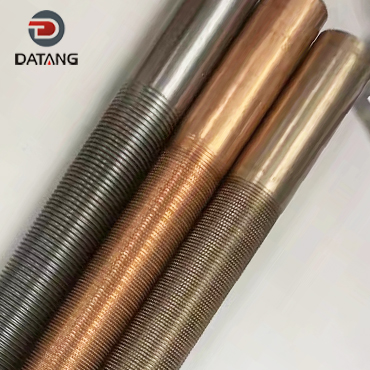Fin Height:
Low-fin tubes typically have a fin height of 1-2mm (e.g., 1.6mm), while high-fin tubes range from 6.4-25mm.
Heat Transfer Efficiency
High-fin tubes, due to their greater fin height, have a larger heat transfer area, thereby improving heat transfer efficiency. This makes them particularly suitable for applications with a significant difference in internal and external heat transfer coefficients, such as waste heat recovery devices in the chemical and metallurgical industries. Low-fin tubes, on the other hand, are suitable for applications with a similar difference in internal and external heat transfer coefficients. Their finning coefficient (the ratio of external to internal surface area) is typically less than 4.
Application Scenarios:
Low-fin tubes are primarily used in pressure vessels such as shell-and-tube heat exchangers, while high-fin tubes are commonly found in air-to-air heat exchangers. Fin size must be adjusted according to operating conditions.
Production Process
The fins are integrally rolled using a three-roll cross-rolling method, forming a seamless structure with the tube body and eliminating contact thermal resistance. With a finning coefficient of 2-3, the heat transfer area is significantly increased, and the fouling resistance is superior to that of bare tubes.
Suitable for applications such as condensers and oil heat exchangers, it can reduce heat transfer area by 30%.

High Fin Tubes
Featuring significantly higher fin height than low-fin tubes, they are commonly used in air-to-air heat exchange equipment (such as greenhouse cooling) to enhance air-side heat transfer.
High-Fin Welding ensures a strong bond between the fins and the tube, making them suitable for high-flow or high-temperature applications.
Structure and Performance Comparison
Heat Transfer Efficiency: Low-fin tubes improve efficiency by increasing the heat transfer area, while high-fin tubes rely on their high surface area to enhance air-side convective heat transfer.
Drag Characteristics: High-fin tubes experience a more pronounced increase in flow resistance with flow rate, requiring higher pump power. Low-fin tubes experience a slower increase in resistance, making them suitable for high-pressure differential applications.
Cleaning and Maintenance: Both tubes are similar in cleaning difficulty and are cleaned using bare tube cleaning methods.
High-fin tubes and low-fin tubes are two common heat exchanger components widely used in industry. However, many people are unclear about the difference between the two and the specific meaning of finned tube diameter. These questions will be addressed in detail below.
Application Scenarios
Due to their higher heat transfer efficiency, high-fin tubes are widely used in large industrial heat exchangers, such as power plant condensers. Low-fin tubes, on the other hand, are often used in ventilation and heat exchange applications where space requirements are stringent and air resistance must be strictly controlled, such as heat exchangers in air conditioner outdoor units.


